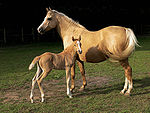- Danube Delta horse
-
Danube Delta horse Country of origin Danube Delta Horse (Equus ferus caballus) Danube Delta horse refers to a population of feral horse found in and around Letea Forest, located in the Danube Delta, between the Sulina and Chilia branches of Danube. About 3600 feral horses live in the Danube Delta, 2000 in the Letea nature reserve, where on one hand, they are among the last remaining "wild" (feral) horses living at large on the European continent,[1] but are also deemed to be a threat to the flora of the forest,[2] including to some plants on the IUCN Red List of Threatened Species.[3]
Although feral horses have existed for hundreds of years in the region,[2] their number greatly increased after the collective farms were closed down in 1990 and the horses belonging to them being freed.[4] Today, the Letea population is not regulated and there are concerns that overgrazing is a looming problem.[5]
The horses on Letea are black or bay, without white spots. They stand between 14.1 and 14.3 hands ( 1.45 to 1.50 metres (57 to 59 in)) and are of a strong build. They are of a different breed than the close by Sfântu Gheorghe breed. They are not of a riding horse build, but are built like working horses of the Nonius type.[5]
In 2002, some of these horses were captured and transported to Italy and slaughtered.[2] Some organizations objected to removal, holding that the horses had value in being adapted to the location and possessing natural social behavior.[5] Another push for removal and slaughter began in 2009,[2] but horses cannot be currently removed from the area because a number of animals carry equine infectious anemia. Therefore, according to Romanian regulation, they are not allowed to be taken out of the quarantine area. Currently, there is an ongoing project, in collaboration with the World Wide Fund for Nature, seeking to find a way to remove these horses.[3] While some organizations object to total removal and advocate for some animals to remain,[5] others are attempting to find a different preserve for the horses to live.[1]
References
- ^ a b "Noah's Ark - Project Horses Romania"
- ^ a b c d (Romanian) "Mustangul de România", Gândul, February 25, 2009
- ^ a b Dezastru ecologic: În Delta Dunării caii sălbatici distrug Letea, Jurnalul Naţional, January 15, 2009
- ^ "Caii sălbăticiţi distrug puieţii din Pădurea Letea", Adevărul, October 12, 2007
- ^ a b c d "Natural and cultural grazing in the Danube Delta." Consultancy Herds and Homelands
External links
- Wild Horses in Danube Delta - Photos
- Wild Horses in Danube Delta - Photo
- Wild Horses Are Destroying Letea Forest (Romanian)
Equine Equine science and
management
Equestrianism
and sportGlossary of equestrian terms · List of Equestrian Sports · Horse tack · Bit · Bridle · Saddle · Harness · English riding · Western riding · Driving · Horse training · Horse racing · Equestrian at the Summer Olympics (medalists, venues) · Horse show · EquitationEvolution and history Domestication · In warfare · In the Middle Ages · Horses in East Asian warfare · History of the horse in South Asia · Horses in the Napoleonic Wars · Horses in World War I · Horses in World War II · History of the horse in BritainHorse breeds, types
and other EquidaeList of horse breeds · Wild horse · Feral horse · Stock horse · Gaited horse · Draft horse · Warmblood · Sport horse · List of horse breeds in DAD-ISOther EquusHybridsCategory: Equidae Categories:- Danube Delta
- Feral horses
- Horse breeds
- Horse breeds originating in Romania
- Mammals of Romania
Wikimedia Foundation. 2010.
